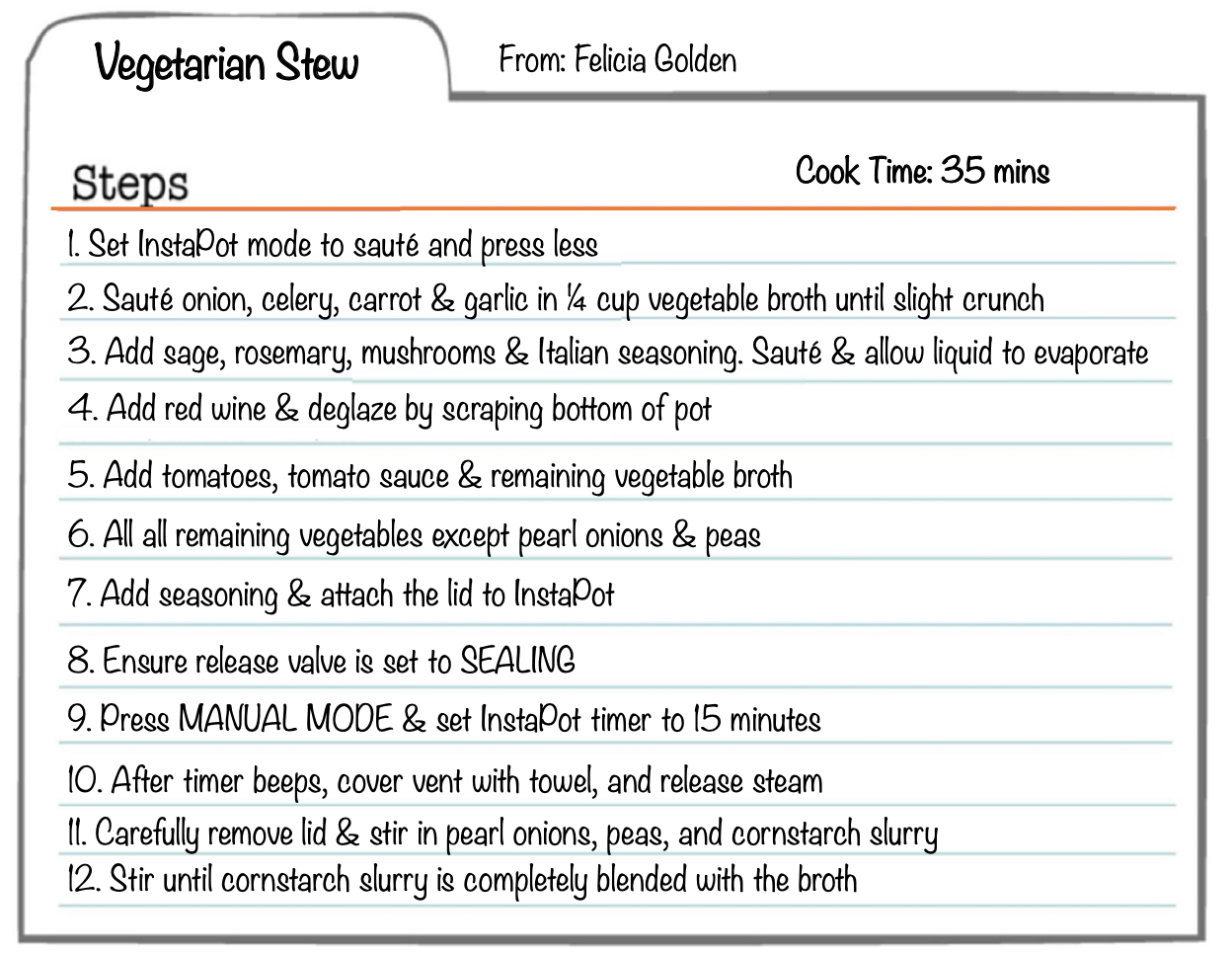10
Felicia D. Golden
“If anyone’s idea about leadership has inspired organizations for thousands of years, it’s the capacity to hold a shared picture of the future we seek to create. One is hard-pressed to think of any organization that has sustained some measure of greatness in the absence of goals, values, and missions that become deeply shared throughout the organization” – Peter Senge
Maybe you’re a leader driving home after a collaborative day exemplified by the successful work completed by your faculty, or maybe your day was busy filled with back-to-back meetings without a minute to grab something to eat; my delicious stew recipe is the meal for you and is the comfort food your InstaPot is created to cook.
Just like a hearty stew full of fresh garden vegetables, seasoned with your homegrown herbs and spices gives your home an aroma that calls your family to the table for dinner, an effective collaborative instructional leader with clear goals can create capacity for learning and equity which will move the school climate and culture forward.
“An effective leader not only has the ability to visualize the endgame but also has the capacity to encourage other leaders to work independently in leading others. These leaders bring about results working collaboratively by implementing, refining, and improving steps taken to achieve the following performance objectives.
Linking and Aligning
Linking curriculum, instruction and assessment ensure purposeful planning and implementation of required curriculum standards to increase student learning and achievement” (Hooper and Bernhardt, 2016, p. 23)
One way to cultivate a collaborative culture while ensuring purposeful creative lesson planning is to have teachers work in teams during PD meetings. Sixth-grade English teachers will be grouped with sixth-grade elective and Math teachers. Seventh-grade English teachers will work with Seventh-grade elective and Math teachers while Eighth-grade English teachers will work with Eighth-grade elective and Math teachers. This ideal grouping will allow the teachers to link curriculum standards while developing project-based lessons. Science grade level teachers will work with History grade level teachers to create lesson plans. Since Math is interwoven into Science, Science instructors will be able to introduce Math related questions into the lesson planning. Lastly, the lesson plans will be based on the Common Core State Standards (CCSS).
Defining Standards
“Standards for learning ensure instructional staff examines the expected depth of knowledge required for student performances defined by each standard within the curriculum” (Hooper and Bernhardt, 2016, p. 23),
Leaders, during a meeting with your department chairs, instruct them to intensively delve into their subjects CCSS with the instructors at the next two-three department professional development opportunities. Also, have the teachers share their successful strategies and reflect on how to change their unsuccessful lessons into successful lessons with the students learning and understanding what they have been taught.
“Adequate teaching build capacity to ensure that research-based instructional strategies are pervasively and consistently implemented with fidelity. At the beginning of the semester, during the first meeting” (Hooper and Bernhardt, 2016, p. 23),
At the first faculty meeting, leaders should project their school’s last year’s California Assessment of Student Performance and Progress (CAASPP) scores onto the screen, acknowledging the at grade level and above grade level scores. They should also highlight the below and far below grade scores in each subject area. Leaders should let the teachers know that they have listened to their concerns about their students and how they want to improve their school’s test scores.
Achieving Greater Levels of Academic Performance
Leaders should also listen to the students about how much they love their teachers and how they want to improve their test-taking scores. Leaders should request that each grade level team collaboratively work on a strategy for achieving the goal to enhance student’s academic performance and share-out with the faculty their plan for achieving this goal.
“Data-driven instruction leads instructional staff in collaborative analysis and inquiry to use assessment results to inform continuous improvement of student learning” (Hooper and Bernhardt, 2016, p. 23), and leaders before the year begins, review the student’s data. If the students are not performing their best work, now is the time to plan how to get the students to be engaged in each subject.
Cultivating a Growth Mindset
As an effective leader, you already know that all students can learn. Students’ home environment, background, and race do not matter – all students have the capability to learn.
“Assessment engage instructional staff in collaborative design of formative and summative assessments to measure progress and inform instructional plans” (Hooper and Bernhardt, 2016, p. 23).
Leaders, during the department professional development workshops, have the grade level instructors collaboratively create a formative and summative assessment to measure the student’s progress.
In closing we should remember like a delicious bowl of hearty vegetable stew the following:
“Regardless of which tools or models are selected, the key commitment is to ensure teachers and other instructional staff members are engaged in the process of collaboratively analyzing the required curriculum in a manner that provides for: (1) systematically identifying and isolating content, (2) determining the cognitive demand, and (3) identifying expected levels of application implied by the standards to ensure a seamless progression from grade to grade” (Hooper and Bernhardt, 2016, p. 30).
“I really believe there’s no such thing as accidents, only opportunities. God gives everyone the ingredients to a good, happy life. It’s up to us to make the most of them.” Rachael Ray.
A Recipe for Your InstaPot

Continued on next page.

